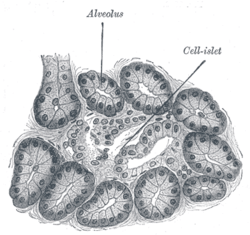Acinus
| Acinus | |
|---|---|
 Illustrated section of pancreas of dog. X 250. (Alveolus labeled at center top.) | |
 Centroacinar cells | |
| Identifiers | |
| Code | TH H2.00.02.0.03050 |
An acinus (/ˈæsᵻnᵻs/) (plural, acini; adjective, acinar [/ˈæsᵻnər/] or acinous) refers to any cluster of cells that resembles a many-lobed "berry", such as a raspberry (acinus is Latin for "berry"). The berry-shaped termination of an exocrine gland, where the secretion is produced, is acinar in form, as is the alveolar sac containing multiple alveoli in the lungs.
Exocrine glands
Acinar exocrine glands are found in many organs, including:
- the stomach[1]
- the sebaceous gland of the scalp
- the salivary glands of the tongue[2]
- the liver
- the lacrimal glands
- the mammary glands
- the pancreas[3]
- the bulbourethral (Cowper's) glands
The thyroid follicles can also be considered of acinar formation but in this case the follicles, being part of an endocrine gland, act as a hormonal deposit rather than to facilitate secretion.
Mucous acini usually stain pale, while serous acini usually stain dark.
The term "acinus" is considered synonymous with alveolus by some sources, but not all.
Lungs
The respiratory bronchioles in the lungs terminate in acini, many-lobed sacs containing groupings of alveoli.
See also
| Look up acinus in Wiktionary, the free dictionary. |
References
- ↑ Histology image: 51_07 at the University of Oklahoma Health Sciences Center - pyloric stomach
- ↑ Histology image: 46_03 at the University of Oklahoma Health Sciences Center - sublingual gland
- ↑ Histology image:10405loa from Vaughan, Deborah (2002). A Learning System in Histology: CD-ROM and Guide. Oxford University Press. ISBN 978-0195151732.